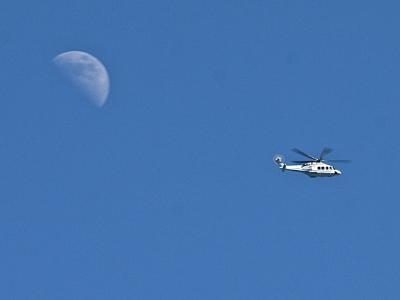Pleas for Relief From Aircraft Noise

Increased traffic to and from East Hampton Airport, coupled with a communication to helicopter pilots stating that the southern route to the airport was unavailable, has brought frustrated East Hampton and Southampton Town residents to a boiling point, and on Tuesday several of the latter pleaded with the East Hampton Town Board to do something about it.
The town board issued a release on Friday quoting a statement from the previous day by Robinson Aviation, which controls air traffic by contract with the town. “There have been no official cancellations of any routes,” according to Keren Williams McLendon, Robinson’s chief executive officer, “including the Sierra route,” the southern approach to the airport. “The Sierra route continues to be utilized upon request if there is not a traffic conflict.”
But that message conflicted with one previously issued by the Eastern Region Helicopter Council to its members “stating that Sierra would no longer be available, which is an unfortunate communication,” Supervisor Peter Van Scoyoc said on Tuesday. “My office didn’t find out about that until after the fact. I think some of the fact that there’s still reduced traffic” on the Sierra route “is the result of those members of Eastern Region Helicopter maybe not knowing that it is available to them.”
The Eastern Region Helicopter Council’s communication to pilots was that “there was a lot of overcrowding of different aircraft types — fixed-wing, helicopter, jets — and the tower chief was concerned they needed not to be intermingled” on the southern route, Deputy Supervisor Sylvia Overby, the board’s co-liaison to the airport, said yesterday.
That statement upset what had been, until the weekend of July 21 and 22, a balance between use of the Sierra and “November,” or northern, pathways to the airport, which the Eastern Region Helicopter Council had previously encouraged through its Fly Neighborly program.
The town’s contract with Robinson Aviation includes an understanding that noise abatement routes are followed, Ms. Overby said. “Robinson put out a statement saying they will be followed,” she said. But a pilot must request the Sierra route in order to use it, according to the statement from Robinson Aviation.
The flight paths are voluntary, Mr. Van Scoyoc said, “because the town has no authority to mandate them. That can only be done by the F.A.A.,” the Federal Aviation Administration. “The town has not changed any of the official noise abatement routes. . . . Our goal has always been to spread Robinson Aviation traffic within those routes equitably and evenly. If you looked at the airport noise abatement routes for both of the weekends around the Fourth of July . . . you will see that there was a fair and equitable distribution.”
That statement was made in response to a “tale of woe” told by Patricia Curry of Noyac, who told the board that her community “has been abused by East Hampton Airport operations for over two decades.” Redirecting of airport traffic over communities north and west of the airport, she said, was a decision likely “made behind closed doors at Town Hall.” East Hampton’s oceanfront and estate areas, she charged, were being shielded from aircraft noise at those communities’ expense, and North Sea, Sag Harbor, North Haven, Shelter Island, Bridgehampton, Wainscott, Northwest Woods, and the North Fork were also negatively impacted. “There’s very little traffic on the South Shore, and there’s not much traffic over Southampton that is not going inland,” she said.
“For years now, homeowners in our area have suffered the deterioration of our quality of life resulting from the dramatic increase, year by year, in fixed-wing aircraft and helicopters flying in and out of” East Hampton Airport, William Reilly, also of Noyac, told the board. The Sierra route had provided some relief to communities “because it has lessened the impact to some degree on any one area,” he said. “At the same time, though, the number of seaplanes and small planes flying low over Noyac has increased dramatically.”
Directing all helicopter traffic to northerly flight paths presented a dangerous condition, Mr. Reilly said. “The risk of helicopters, seaplanes, jets, and small fixed-wing aircraft already jockeying for space over our community is absurd.” He implored the board to “make consistent, sincere efforts to bring an end to this insanity.”
Gene Polito, also of Noyac, echoed his neighbors. “There is no upside to aviation except quickness,” he said. “From every other point of view it’s a damaging technology. For the environment, for human beings, for animals, it impacts everything negatively. . . . You own the airport,” he said. “Get creative. Be forceful. Do something. These are dangerous conditions. You should have some kind of grounds upon which to base some kind of action to get some kind of result. You’re the proprietors.”
The town board successfully enacted curfews that were in effect for the better part of two summers, Mr. Van Scoyoc said. In 2016, however, a federal appeals court ruled that the town could not independently enact use restrictions. Instead, it must follow the federal Airport Noise and Capacity Act and seek federal approval.
That decision prompted the town to launch an analysis known as a Part 161 study, which airport owners must perform when proposing local noise or operational restrictions on aircraft. The process is ongoing, Ms. Overby said yesterday. “It’s unfortunate that the court sent us back to do this,” she said. “I continue to be frustrated by how it all transpired.”
“I know Patricia is frustrated,” she said of Ms. Curry. “I can understand it. I’m frustrated as well . . . that we have not had help necessary on the federal level to control our own airport.”
